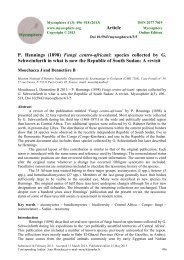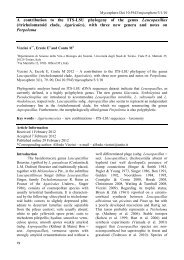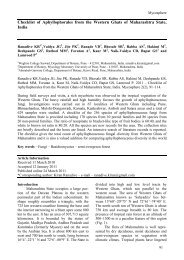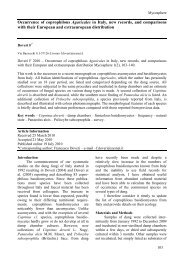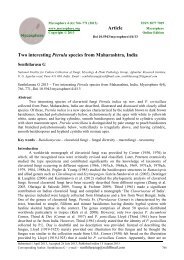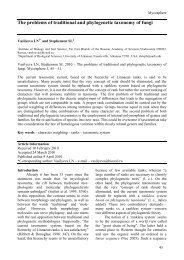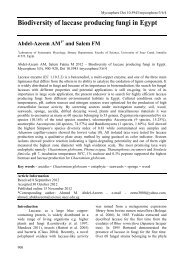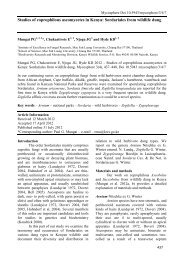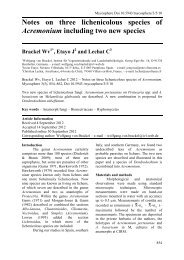Fungi Fimicoli Italici - Mycosphere-online journal
Fungi Fimicoli Italici - Mycosphere-online journal
Fungi Fimicoli Italici - Mycosphere-online journal
You also want an ePaper? Increase the reach of your titles
YUMPU automatically turns print PDFs into web optimized ePapers that Google loves.
Table 43 Records from Italy of coprophilous Chaetomidium on different dung types (n° of dung samples in damp chamber cultures, in square<br />
brackets)*°.<br />
366<br />
beech–<br />
marten<br />
[3]<br />
bird<br />
[27]<br />
cattle<br />
[55]<br />
horse<br />
[63]<br />
C. cephalothecoides 2 4 2 4<br />
(15%) (4%) (6%)<br />
C. fimeti 1<br />
(2%)<br />
C. megasporum 1<br />
Total<br />
Chaetomidium in<br />
natural state<br />
1<br />
Total<br />
2 4 2 5<br />
Chaetomidium in<br />
damp chambers**<br />
(15%) (4%) (8%)<br />
fallow<br />
deer<br />
[10]<br />
cervine leporine<br />
roe deer<br />
[37]<br />
goose<br />
[1]<br />
hare<br />
[20]<br />
1 (10%) 3 (8%) 1 2<br />
(10%)<br />
1<br />
(10%)<br />
3<br />
(8%)<br />
1 2<br />
(10%)<br />
rabbit<br />
[19]<br />
3<br />
(16%)<br />
3<br />
(16%)<br />
goat<br />
[16]<br />
5<br />
(31%)<br />
5<br />
(31%)<br />
hedgehog<br />
[12]<br />
insect<br />
[9]<br />
2 (17%) 1<br />
(11%)<br />
2<br />
(17%)<br />
1<br />
(11%)<br />
lizard<br />
[3]<br />
marmot<br />
[5]<br />
pig<br />
[5]<br />
polecat<br />
[5]<br />
sheep<br />
[51]<br />
2 1 (20%) 1(20%) 2(40%) 8<br />
(16%)<br />
2 1 (20%) 1<br />
(20%)<br />
2<br />
(40%)<br />
8<br />
(16%)<br />
tortoise<br />
[2]<br />
weasel<br />
[1]<br />
1 1<br />
1 1<br />
(8%) (13%)<br />
* The frequency (%) is not reported when samples of a dung type are less than five. ° Records from dung in the natural state, in normal type. Records from dung in damp chambers<br />
and frequency (%), in bold type. ** The frequency (%) of a genus as whole, on each dung type in damp chamber, results from the ratio between the total number of occurrences of<br />
that genus and the number of dung samples [ ]. The total occurrence of a genus does not result from a simple addition of occurrences of all species belonging to it, because the genus<br />
as whole must be regarded as occurring only once in one sample even if two species, or more, occur in that sample.



